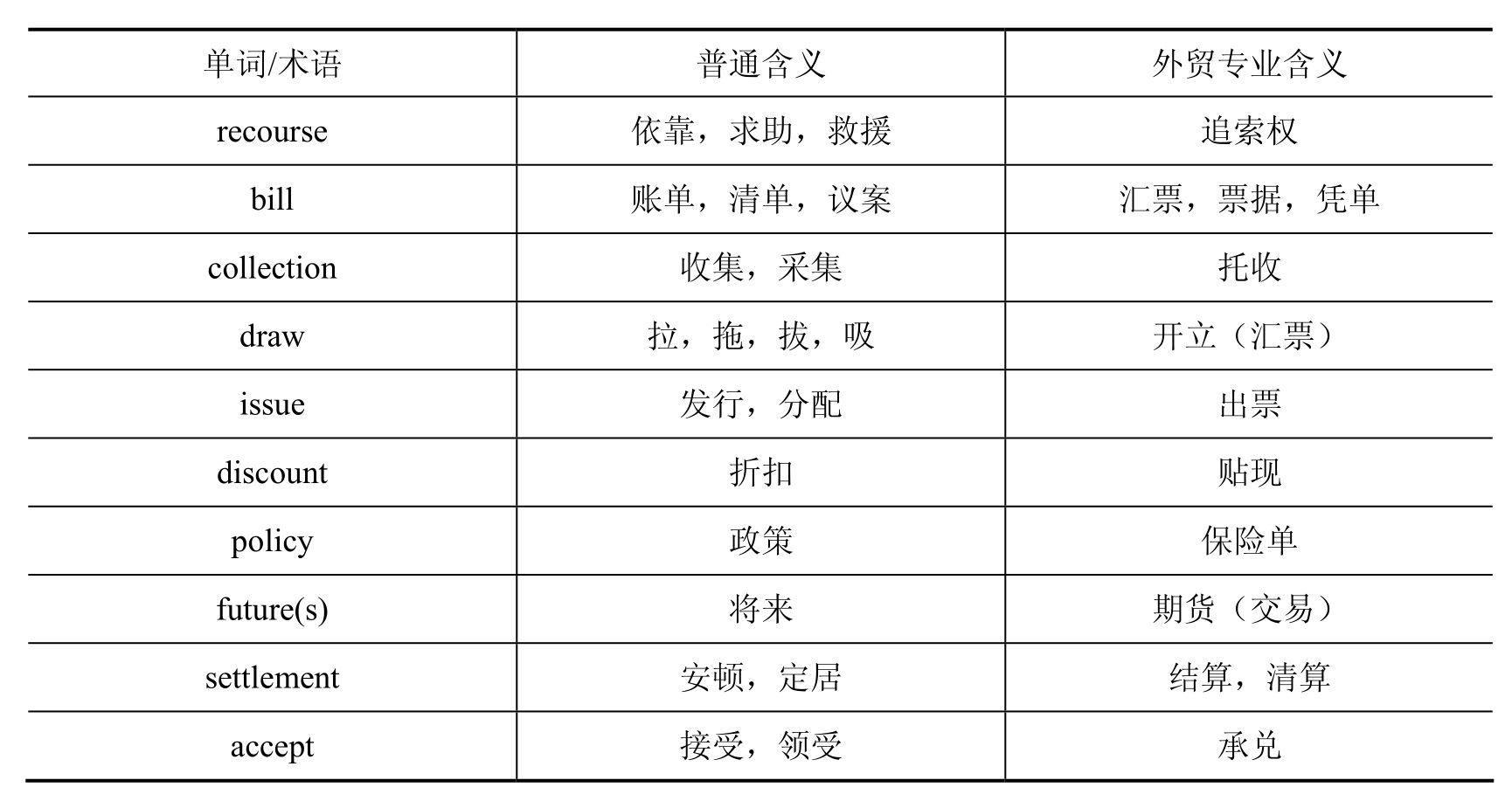第二节 信用证英语的语言特点及翻译
信用证英语属专门用途英语(English for Specific Purposes,简称为ESP),具有法律文本的一般特点:行文严谨,用词准确、规范、正式,专业性强。
一、信用证的词汇特征及翻译
1.信用证常使用专业术语
信用证里大量使用专业术语,包括一些在函电里所使用的缩略语。外贸行业所使用的专门术语,不了解外贸业务的人很难准确地理解它的确切含义。如:bona fide holder 善意持有人(议付行向受益人垫付资金、买入跟单汇票后,即成为汇票持有人,也就是善意持有人);neutral document 中性单据(指不表现出口商名称的单据)等。
下面是一些常用单词和专业术语的词义转义比较:

续表

2.某些多义词在信用证中的特殊含义
例如:All bank charges outside U.K. are for our principals’ account, but must claimed at the time of presentation of documents.
在英国境外发生的所有银行费用,应由开证人负担,但必须在提交单据时索取。
这里的principal 不是“首长”,“主要的”之意,而是指开证申请人。
Upon receipt of complaint documents, we undertake to remit proceeds by telegraphic transfer in terms of your instructions in two working days.
当收到该证项下相符的单据时,我(开证行)保证在两个工作日内按贵行指令付款。
“proceeds”这里是“款项”之意,而不是指“前进”;“acceptance”不是“接受”之意,而是“承兑”,即远期汇票的付款人明确表示同意按出票人的指示,于票据到期日付款给持票人的行为。
再如:Drawee bank’s charges and acceptance commission are for buyer’s account.
付款行的费用和承兑费用由买方负担。
collect 一词在信用证中出现,不是“收集”,而是“到付”的含义。“freight collected”即“运费到付”。
3.古体词语使用较多
古体词语主要是here,there加上介词构成的复合词。如:hereby=by means of(以此方式,特此),herein=in this document(此中,在此文件中),thereby=by that means(因此;在那方),therein=in that;in that particular(在那里;在那点上)……这些词语的使用可避免一些不必要的重复,同时可以使文体显得正式,庄重。如:
We hereby engage that all drafts drawn under and documents presented hereunder—will be duly honored by US provided that the terms and conditions of the credit are complied with.
我行保证凭符合本信用证之汇票及单据付款。
4.介词短语的使用
信用证常使用简单的介词结构取代从句来表达复杂的含义,体现出这种文本简洁、正式的特点。翻译时可将从句结构表达出来。
against一词在信用证中出现的频率很高,而其在信用证中的词义与在普通英语中完全不同。在普通英语中,against是介词,可以表示“反对”,“碰撞”,“紧靠”等意思。但在信用证中,against一词用来表示“凭……”,“以……”,它在信用证中的词义在一般的字典中并没有出现。如:
This credit is valid until November 20,2003 in New York for payment available against the presentation of the following documents.
本信用证在2003年11月20日在纽约到期前,凭提交以下单据付款。
再举几个类似例子:
Upon presentation of the documents to us, we shall authorize your head office banking department by airmail to debit the proceeds to our foreign business department account.
一俟向我行提交单证,我行将用航空邮件授权你总行借记我行国外营业部账户。
On receipt of the required documents which comply with the terms of this credit,we will remit proceeds in accordance with your instructions.
当收到该证项下相符的单据时,我(开证行)将按贵行指令付保证金。
Documents must be negotiated in conformity with the credit terms.
与该证相符的单据须议付。
5.分数、数字、日期表达的正确理解与翻译
份数:
in duplicate 一式两份;in triplicate 一式三份;in quadruplicate一式四份;in quintuplicate一式五份;in sextuplicate 一式六份;in septuplicate 一式七份;in octuplicate一式八份;in nonuplicate 一式九份;in decuplicate 一式十份
数字:
1/3 original B/L must be sent to the opener by airmail.
三份正本提单中的一份必须通过航空件寄给开证人。
日期:
a. 如果装船日期为:在某月某日之后,和在某月某日之前,应使用after和before. 如:6月25日之后,7月10日之前装船。应译为:Shipment will be effected after the 25th of June and before the 10th of July. 在此,after和before应理解为不包括所提到的日期。即6月25日和7月10日装船是错误的。
b. 如果装船期为:到某月某日止,从某月某日,直到某月某日等词,用to,from,until. 使用这些词时,应理解为包括所提到的日期。如:Time of shipment:from 10th to 20th August. 10日和20日都包括在内。
c. 如果装船期规定为:最晚不迟于9月30日,一般表述为:Latest date of shipment:30 September.
二、信用证的句法特点
信用证中的语言是格式化的语言,其特色主要体现在信用证的特别条款部分,也就是单证条款之外的附加部分。其总体特点是表述复杂,有较多的长句,要理解句意就需要反复斟酌推敲。信用证英语有法律英语的特点,法律英语结构严谨,句式复杂。因此解读信用证需要了解其行文风格。本章将对信用证行文的句法特点加以总结,并举例说明。
1.使用被动语态
被动语态可以用来突出强调一个动作的对象,而忽视动作的完成者。信用证的文体和语言环境决定了它需要强调客观事实,因此,被动语态的出现频率相当高。使用被动语态的句子,结构可以有较大的调节余地,比主动语态的主观色彩更少,适合在严肃和庄重性的文章中出现。然而,翻译的时候并不一定要把被动语态翻译出来。下面是一些例子:
例1:Drafts and documents are to be couriered one lot to Bank of China, Shanghai Branch.
汇票和单据一次寄单至中国银行上海分行。
例2:Packing list in one original and 5 copies, of which must be manually signed.
装箱单一份正本,五份副本,所有必须手签。
例3:The negotiating bank is authorized by the issuing bank to claim reimbursement from Citibank New York via SWIFT provided that all terms and conditions are fully complied with and that documents were dispatched directly to the issuing bank.
开证行授权议付行通过SWIFT方式向花旗银行纽约分行索偿,只要信用证的各项条款和条件得以满足同时单证已经寄到开证行。
例4:Notwithstanding any terms and conditions in this credit, an additional handling fee of USD 60.00 (or equivalent) will be deducted from the amount of drawing(s).
尽管本证有条款或条件之规定,但额外的处理费60美金(或等同)将从出票金额中扣除。
另外,在偿付文本中通常用主动结构表被动含义,汉译时用“由……”的结构引出句主语。例如:
All banking charges outside Japan are for account of beneficiary.
在日本境外发生的所有银行费用均由受益人负担。
2.使用平行结构
平行结构是英语中用相似的语法形式来表达相似的句子成分的方法,其特点在于简单明了,信息量大。成平行的方式多为单词和短语,有时候也有句子的并列。信用证中会逐一列举平行成分,显得井井有条,十分醒目。例如:
例1:Partial shipment not allowed.
Transshipment not allowed.
不允许分批装运。
不允许转运。
例2:Weight memo/Packing list in 4 copies
Certificate of quality/weight in 2 copies
重量单/装箱单四份
数量/重量证明两份
3.使用非完整句
英汉两种语言具有不同的句式结构,这是汉语和英语在语言学上的一个主要区别。英语句子重形合(Hypotaxis)而汉语句子重意合(Parataxis)。英语句子的句法特征主要为主次较为分明、逻辑关系严谨,其意义的变化往往和形式的变化紧密相关,而汉语的意义一般来说不会受到形式的约束,它是一种意念的流动。汉语的意念表述大多通过内在的逻辑联系贯穿前后,而不过多注重外在的形式结构。从句子的构成上来说,一个完整的英语句子通常必须有一个谓语动词,不管是行为动词还是系动词,然而汉语与之不同,因为没有动词也同样可以成为句子。信用证英语,基于其文本结构的完整性和表意的严密性的需要,其句子结构一般采用主语和谓语都具备的完整句。使用完整句,能有效地使所要表述的内容完整地体现出来。但是信用证英语具有其他科技文体所没有的行文特点:经常故意省略句子的助动词或系动词结构,有意识地造成句子语法结构错误,使句子成为非完整句。非完整句的目的是为了突出名词在句中的中心词地位。信用证英语的特殊性使得名词在信用证英语中所出现的频率比其它任何词性所出现的频率都高。
Shipment from Kunming to Genoa Port no later than February 28, 1998, documents to be presented within 15 days after the date of issuance of the shipping document but within credit validity in case shipment is not effected within the time stipulated above an automatic extension of 15 days is allowed both for the time of shipment and that of expiration of the credit.
装运从昆明至热那亚港,不得迟于1998年2月28日,单据于装船单据签发日期后15天但须在信用证有效期内提交议付。如果装船无法在上述规定时间内实施,本信用证的装期和效期均允许自动延长15天。
本句是一个非完整句,中心词是名词shipment和documents,也是条款要传送信息的中心,而后置的条件句in case部分则是辅助的结构。从语法上来分析,句子表面在shipment 和documents后面存在一个虚拟的长定语修饰部分。条件句in case完全后置,句子的重心弱化。然而,从另一个角度分析,本句实际上内含一个主谓结构,那就是,如果在shipment 和documents后面分别加上is和are,则句子结构就成为完整句了,句子的语法结构也就正确了。
4.使用条件句
在信用证中,引导条件句的词有很多,例如:in case of,only if,only after,provided,unless,if,in view of,on condition that,providing that。使用条件句可以明确表明该信用证中所列的限制性条件,规范相关方的行为。例如:
例1:In case of transfer, document No. (K) is no more required provided that the Bank of China, Lianyungang certifies it has transferred the credit.
如果要转让,只要连云港中国银行证明已将信用证转让,就不需要提交K号单据。
例2:Transshipment is allowed on condition that the entire voyage be covered by through B/L.
如果提供转船提单,则允许转运。
例3:We authorize you to pay beneficiary and claim reimbursement from reimbursing bank if documents presented are in full conformity with L/C terms.
如果所提交单据与信用证完全相符,我方则允许你方向受益人付款并要求偿付行偿付。
例4:Third party shipper/documents are permitted provided that such third party is not any person with whom U.S. persons are prohibited from doing business under U.S. foreign assets control regulations or other applicable U.S. laws and regulations.
只要第三方不是美国《外国人资产管制法》或其他美国法律和规定下所禁止的美国人与之交易的人员,第三方托运人或单据可以接受。
5.使用插入语
英语在行文过程中有个特点:随时穿插一些解释说明性质的文字,即插入语。这样的特点有时会造成句子结构混乱松散。这就需要抓住此类句子的逻辑主线,看清其作用是或陈述,或表原因,或表转折。
信用证中的插入语成分使得句子变得相当复杂难懂,稍不留神便会造成失误。我们应先分析清楚插入语的修饰成分或者对象,把握句子的整体结构,找出其中心内容,主谓结构,非谓语动词,介词短语和从句的引导语等等。认清上述结构后,才能着手进行翻译工作。例如:
Notwithstanding the rule referred to in article 14 (D) and (E) of UCP 500 dealing with the procedures to be adopted by banks in the process of refusing discrepant documents, with particular reference of placing the documents at the disposal of, or returning them to the presenter, we shall, unless we are instructed otherwise in your remitting schedule, release the discrepant documents to our customers without further reference to the presenter in the event that these documents have been taken up by the applicant/our customers subsequent to our refusal of these documents.
尽管UCP500统一惯例中14款(D)和(E)就有关银行拒付不符点单证程序之规定,尤其涉及保留单证并退回单证于交单人处理,但是,除非你方索偿另有指示,我方将把有不符点之单证放单于我方客户而不再进一步接洽交单人,只要在我方拒付这些单证后申请人或我方客户已接受本单证。
本句中有两个插入语部分(A)with particular reference of placing the documents at the disposal of, or returning them to the presenter和(B)unless we are instructed otherwise in your remitting schedule。首先,我们要分析插入语的修饰成分。通过上下文和句际间的逻辑关系分析,我们看到第一个插入语是对前述名词中心词rule进行修饰。从语法关系分析,rule与插入语(A)是一种同位语的关系,插入语(A)是对rule作进一步的补充和说明。在插入语(A)部分出现了断裂or returning them to the presenter。实际上,断裂部分和前述的with particular reference of placing the documents at the disposal of是一种并列关系,是对前述with particular reference of placing the documents at the disposal of的意义追加和补充。插入语(A)的复杂之处还在于名词中心词rule后面连续出现的三个定语修饰成分:referred to, dealing with和动词不定式作定语的to be adopted。而插入语(B)则是对句子的主干谓语部分,即谓语动作“放单”(release)进行修饰。插入语(B)是一种条件的选项。在特别条款的分析过程中,如果熟悉UCP500业务,理解起来就容易多了。UCP500统一惯例中14款(D)和(E)对不符点单据的处理作了明确的规定。从UCP500条款的定义上,我们可以看出,本特别条款是对UCP500的违背,因为这里的特别条款的表述和UCP500是相互矛盾的。关于插入语的翻译问题,可以根据其在句中的逻辑关系,采取拆分独立成句或以修饰性短语的方式出现。比如上述插入语(A)可以翻译成修饰性短语“尤其涉及保留单证并退回单证于交单人处理”对前述中心名词进行修饰。
免责声明:以上内容源自网络,版权归原作者所有,如有侵犯您的原创版权请告知,我们将尽快删除相关内容。















